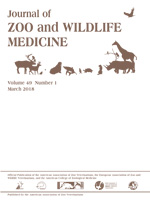Pigmentation of the skin is a crucial component in the pathogenesis of melanocytic neoplasms and other skin-related tumors, as melanin is known to function in both the absorbance of ultraviolet radiation and as an antioxidant. Very limited information exists regarding the incidence and metastatic potential of neoplastic conditions of the skin in game animals, especially wildebeests, relative to domestic animals. Four cases of cutaneous melanoma in color-variant golden and king wildebeests (Connochaetes taurinus) (from 2014 to 2015) in South Africa were investigated. Melanoma in these captive animals was characterized using histopathology, transmission electron microscopy, and an immunohistochemistry panel, which consisted of monoclonal antibodies against three melanocytic markers: Melan A, PNL2, and S100. Overall, 2/4 cases (50%) of the melanocytic neoplasms stained strongly positive for all the melanocytic markers, while 4/4 cases (100%) stained positively for at least one of the markers. Cutaneous melanocytic neoplasia has not been reported in wildebeests; the current study suggests that selection of wildebeests for coat color potentially predisposes to this condition.
How to translate text using browser tools
1 March 2018
MELANOMA IN GOLDEN AND KING WILDEBEESTS (CONNOCHAETES TAURINUS)
Shakirat A. Adetunji,
Rosina C. Krecek,
Nicolize O'Dell,
Leon Prozesky,
Johan Steyl,
Angela M. Arenas-Gamboa
ACCESS THE FULL ARTICLE
Color variant
Connochaetes taurinus
immunohistochemistry
malignant melanoma
melanocytic markers
wildebeest





